A gratitude practice can be life changing. But can toddlers and preschoolers practice gratitude? At first I didn’t think so, but we’ve discovered a sweet way to end our day with gratitude, and it has become our favorite family tradition.
A Science Based Gratitude Practice for Young Children
Research shows that daily gratitude practices can make you happier and healthier (more on that later). But research doesn’t tell us HOW to teach small children to practice gratitude.
Developing a science-based gratitude practice was a huge part of my fertility journey, and I knew that when I had children I wanted to help them learn to practice gratitude each day of their lives.
I started when my son was two and half. I failed miserably. I tried different methods while he was three and also failed. FINALLY, when my daughter was two and my son was five, I found a simple, easy daily rhythm that included a low-pressure daily gratitude practice for the whole family.
AND IT WORKED. And ten months later, it is still working and has become our favorite family ritual.
And I’m going to tell you how :-).
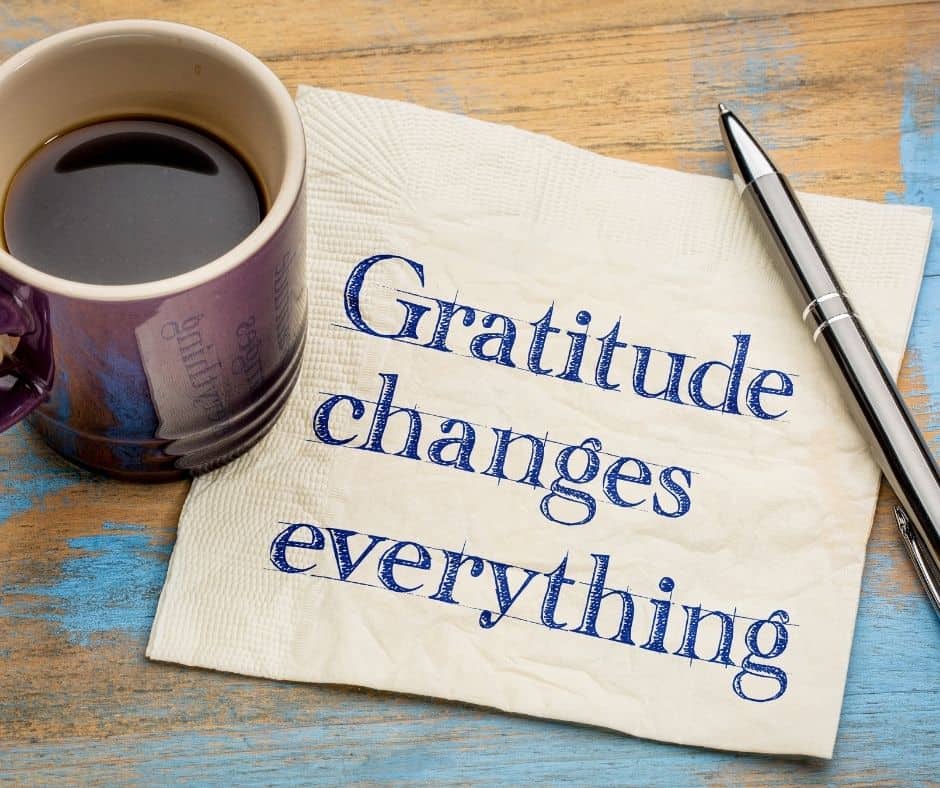
Why Gratitude is Important for Children
You might think I’m going to talk about not being spoiled, or being thankful for all our blessings. But I’m not. It’s not that I don’t think those things are important- I do! Just like everyone else, I fear raising spoiled children.
Interestingly, according to Ron Leiber in The Opposite of Spoiled (which I highly recommend!), for most parents the number one fear in parenting is that their children will turn out spoiled. And, it turns out, that the number one way you get spoiled kids is if you behave as spoiled parents. So, teach your children about money, be generous, and teach your children to be generous. And worry about other things. But, I digress.
So, yes, I fear spoiled children. But even more than that I fear that my children will be unhappy. I have seen so many people struggle with true happiness their whole life, and I don’t want that for my children. I want my children to find joy easily, to rest in happiness.
How do we do that?
Gratitude. At least, that’s what science says.
(Here’s a nice Harvard article on happiness and gratitude).
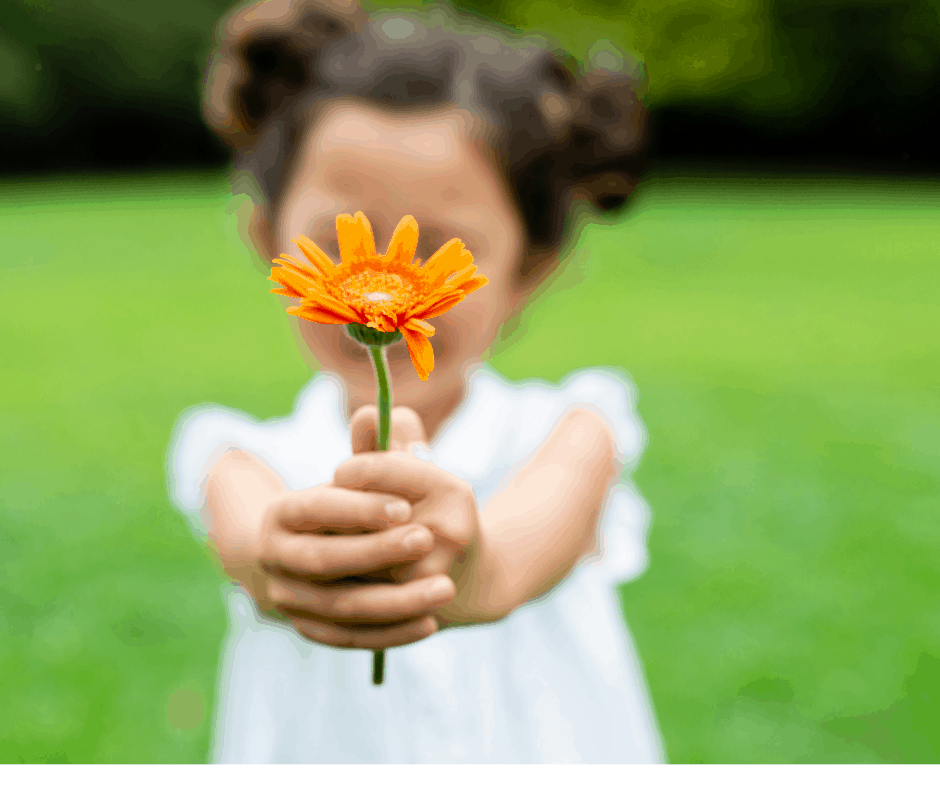
What kind of gratitude practice is evidence based?
So, it turns out that forcing children to say, “I am grateful for . . .” doesn’t always work. Understanding the concept of “gratitude” can be very difficult for a young child. They can say “thank you” and experience the feeling of gratitude, but in my personal experience getting them to use the word “grateful” failed.
But, the good news is that it doesn’t matter. Why? Research shows us the key to a working gratitude practice is to spend two minutes every day scanning your life for three NEW things to be grateful for. What you are looking for is things that made you HAPPY. When you remember them (and for a grown-up, journal them), you should make those things as specific and detailed as possible. The simple act of writing out the details of what made you happy, causes you to in some way relive that happiness for a moment- thus increasing your time spent being happy that day.
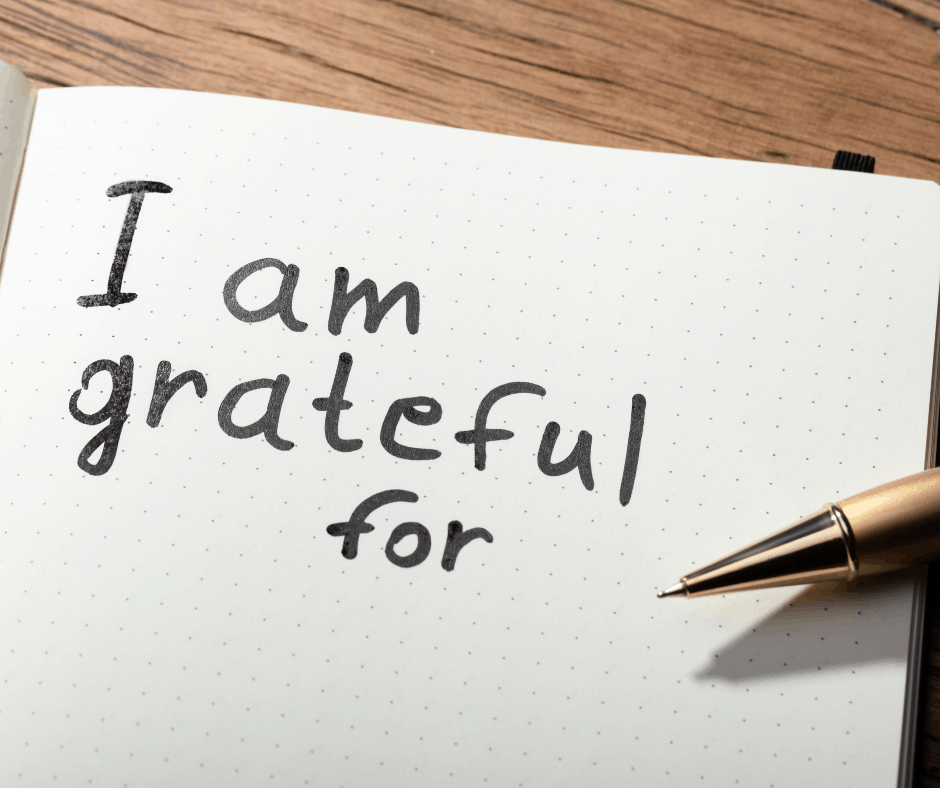
My failed attempts at gratitude practices with toddlers
So, I knew how important my personal gratitude practice was, and I wanted my children to start young. So at night when I was putting them to sleep (usually just me and the child), I would prompt them to say what they were grateful for. Or I would try to encourage them in their prayers to thank God for specific things. And although I modeled this, it was very difficult for my children to do.
Eventually my son outright refused.
The one thing I did learn what that using the word “thankful” was much easier for my children to understand than “grateful.”
But for a while I just gave up.
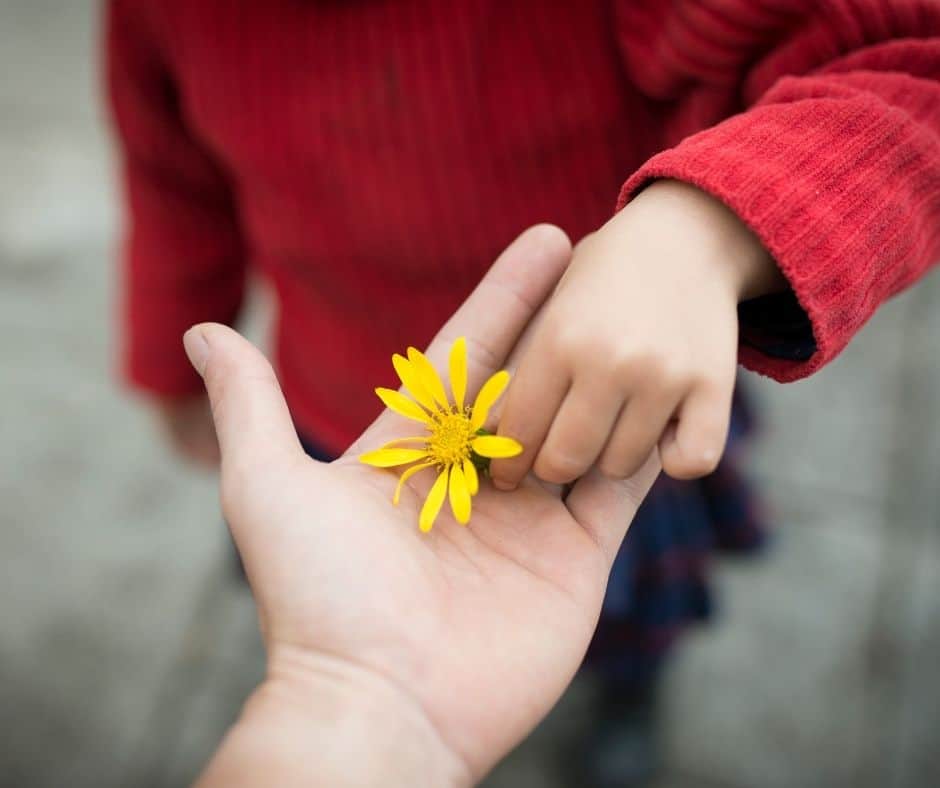
How our terrible evening routine gave birth to our favorite family ritual
Okay, maybe it wasn’t terrible. But I tell you what, those 45 minutes or so after dinner and before bedtime were always a nightmare. And then when it was bedtime, the stress and hyperactivity from those 45 minutes led to stress before we started our bedtime routine.
Why were our evenings so crazy? Well, we we trying to do the dishes, make sure both adults were prepped for work in the morning, bathe the children (Sometimes), and keep the children from melting down. In retrospect, what we should have been doing was ignoring the dishes and our need to prepare, and just sitting and playing games and reading books. But, hindsight is 20/20! That’s what we do know- older and wiser!
BUT, before we fixed those 45 minutes I realized that we needed a SOLID, happy, and gentle transition to bedtime. I thought, wouldn’t it be nice if we came together as a family, and were just TOGETHER instead of rushing around? Wouldn’t it be nice if we had a moment to check in with each other?
And thus, our nightly “family meeting” was born.
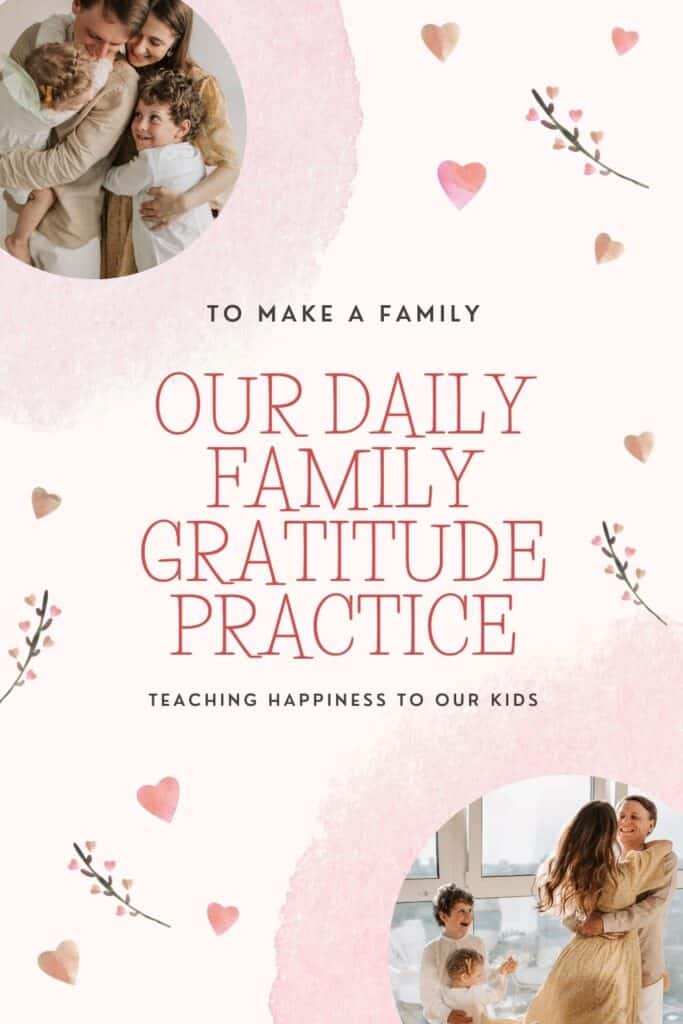
Our Nightly Family Meeting & Gratitude Practice
Once I had convinced hubby we needed a nightly “Family Meeting” to help transition to bedtime, I needed some kind of sweet and quiet activity for those moments. AHA I thought! A chance to try a gratitude practice again!
Luckily, I had been listening to talks by Shawn Anchor, a happiness scientist, and I knew that the best and easiest way to make gratitude turn into happiness was by scanning your day for three NEW things you are grateful from the day. So I know I needed to help my children scan their day and remember the fun and happy things they had done. And then I needed to help them identify them and say them outloud.
There are only three steps in our nightly family gratitude practice:
- The “Raise Your Hand Game.” In this game we take turns saying “Raise your hand if . . . ” and finish with happy memories from the day. For example: “Raise your hand if you went on a hike today.” “Raise your hand if you built legos with Daddy today.” “Raise your hand if baked cupcakes today.” “Raise your hand if you had noodles for dinner.” “Raise your hand if you video-chatted with Baba and Pa today.” Etc. This is fun, and we work in jokes for laughter. The kids get to add their own if they have them. The beauty of this activity is that it is fun, it brings us together as a family, and it preps the kids memories for the next activity.
- What made your happy today? Then we go around and say what made us happy that day. That is the language we use, because it is language both my children can understand and speak. Each person is encouraged to say three things (At least) that made them happy that day. Sometimes my son tries to say the same things every day (“going outside, my sister, and reading), and we gently help him come up with new things, or help him get more specific in those (e.i., playing blocks with my sister, playing in the mud outside, etc.). This is the gold.
- Hugs and Kisses. We alternate who puts who to sleep in our house. One night its me with my son and hubby with daughter. Then next night I put our daughter to sleep, and hubby puts son to sleep. So before we split into our pairs for the evening, we give hugs and kisses.
We used to finish with the Our Father, but we realized that our kids had lost their attention span by then. So we just say the Our Father and nightly prayers with them individually when putting them to sleep.
In all honesty, sometimes we need a transition activity before our transition activity, haha. So sometimes before Family Meeting one adult reads books quietly with the kids while the other finishes the dishes, or we sing a quiet song together.
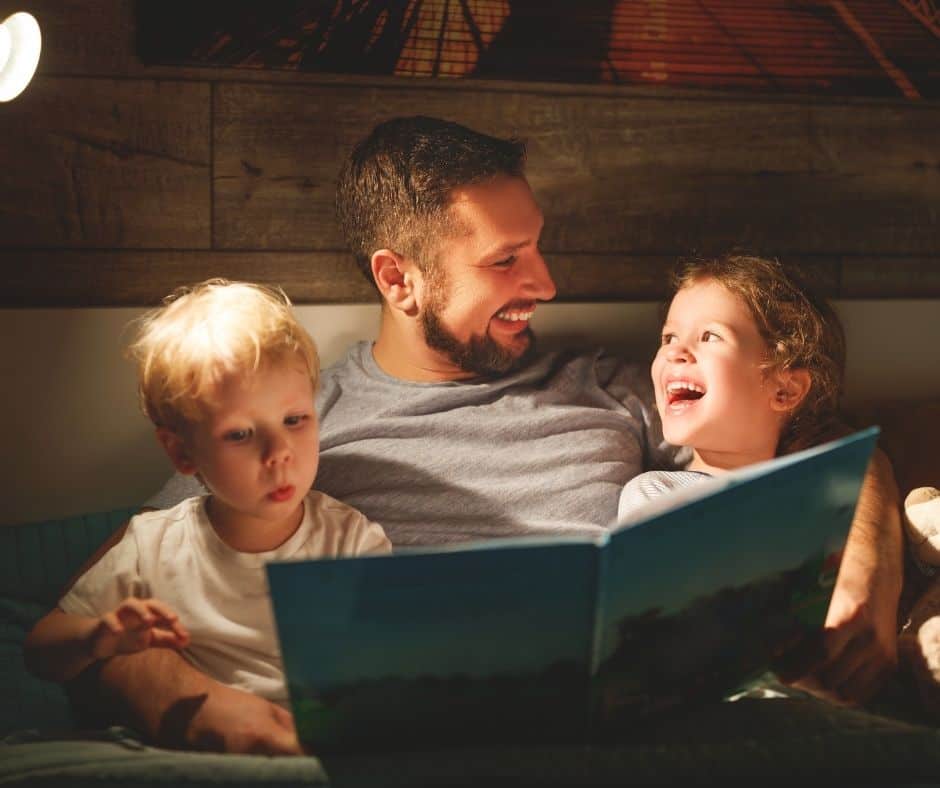
How our evening family gratitude practice has changed our lives
Honestly, this little ritual has been a game changer. It has eased our evenings, made bedtime transitions so much easier, brought us closer together, and created a successful gratitude practice that we share. I only wish I’d thought of it earlier!
One of the blessings of this practice is that it has enabled us to help our kids start understanding and talking about what makes them happy- and what doesn’t. For example, our son really thrives when he goes outside every day. And he has a tough time if he is indoors. But MAN can it be difficult some days to get him outside.
We tried to explain to him that he was a happier kid when he went outside, but it didn’t really sink in. But what did sink in was when he realized that after playing outside that was always his happiest time of the day. He realized that in our family meetings, and it has been a game changer for getting him to go outside!
(Also, if anyone can explain this bizarre behavior of not wanting to go outside even when it is your favorite activity, please email me immediately :-).
What are your favorite gratitude practices with children? Do you have daily family rituals that bring you together? I’d love to hear about them in the comments!
Anna Rapp has a Masters in Business Administration and another Masters in Public Policy and Administration. But, she quit her cool policy job out of a desire to be home with two miracle children she had after infertility. Now she blogs at To Make a Mommy about fertility and at To Make a Family about green living, healthy recipes, and gentle parenting. She lives in Virginia with her husband and two kids!


Leave a Reply